|
||||||||||||||||||||||||||||||||||||||||||||||||||||||||||||||||||||||||||||||||||||||||||||||||||||||||||||||||||||
|
|
|
|
||||||||||||||||||||||||||||||||||||||||||||||||||||||||||||||||||||||||||||||||||||||||||||||||||||||||||||||||||
|
||||||||||||||||||||||||||||||||||||||||||||||||||||||||||||||||||||||||||||||||||||||||||||||||||||||||||||||||||||
|
Climate of trust: Options for protecting the climate beyond Kyoto Christiana Figueres, Center for Sustainable Development in the Americas, introduced WRI’s publication, “Building on the Kyoto Protocol: Options for Protecting the Climate”, on ways to strengthen the climate regime once the Protocol enters into force. Kevin Baumert, WRI, noted the importance of bridging the north-south divide on climate change, and introduced the panel, each of whom described a chapter from the book. Harald Winkler, Energy and Development Research Centre, described WRI’s sustainable development policies and measures (SD-PAMs) proposal, a pledge-based approach to developing countries’ participation in climate change mitigation. He explained that the SD-PAMs approach focuses on implementing policies for sustainable development, rather than setting emissions targets, and involves: outlining future development objectives; identifying PAMs that would make the development path more sustainable; quantifying changes in GHG emissions of particular SD-PAMs; identifying SD-PAMs that create synergies between sustainable development objectives and climate change policy; and summarizing the net impact of a SD-PAMs “basket” on development benefits and GHG emissions. Yong-Gun Kim, Korea Environment Institute, outlined a proposal for dual-intensity targets, premised on the idea that uncertainty about future GHG emission levels impairs the process by which emissions targets are set, and combines the ideas of dynamic and dual targets. He noted that the dual-intensity target approach involves setting two emissions-intensity targets for each country. He said reductions below the lower target would enable the country to sell emission allowances, exceeding the higher target would require the country to purchase emission allowances to remain in compliance, and no penalty would apply if the emissions intensity lies between the two targets. Osvaldo Girardin, Bariloche Foundation, provided an analysis of the Argentine Voluntary Commitment to reduce emissions, noting that Argentina’s experience in proposing a target provides valuable lessons for countries considering a voluntary target. Odile Blanchard, WRI, outlined a quantitative assessment of three scenarios for differentiating commitments: the “per capita convergence scenario”, which allocates emission allowances based on population; the “relative responsibility” scenario, which distributes emission allocations according to an indicator of relative responsibility for climate change; and the “emissions-intensity target” scenario, which applies country-level targets based on the ratio of carbon dioxide emissions to gross domestic product. She highlighted that in all scenarios, Annex I countries will have more stringent emission limitations than non-Annex I countries, and emissions allowances will be above 1990 levels for all non-Annex I countries. |
||||||||||||||||||||||||||||||||||||||||||||||||||||||||||||||||||||||||||||||||||||||||||||||||||||||||||||||||||||
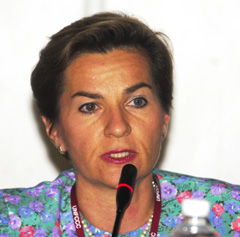 |
||||||||||||||||||||||||||||||||||||||||||||||||||||||||||||||||||||||||||||||||||||||||||||||||||||||||||||||||||||
|
Christiana Figueres, Center for Sustainable Development in the Americas |
||||||||||||||||||||||||||||||||||||||||||||||||||||||||||||||||||||||||||||||||||||||||||||||||||||||||||||||||||||
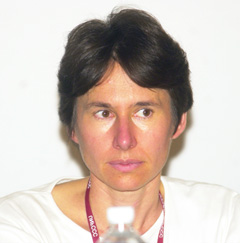 |
||||||||||||||||||||||||||||||||||||||||||||||||||||||||||||||||||||||||||||||||||||||||||||||||||||||||||||||||||||
|
Odile Blanchard, WRI, says that the three scenarios yield varying abatement costs across countries |
||||||||||||||||||||||||||||||||||||||||||||||||||||||||||||||||||||||||||||||||||||||||||||||||||||||||||||||||||||
|
||||||||||||||||||||||||||||||||||||||||||||||||||||||||||||||||||||||||||||||||||||||||||||||||||||||||||||||||||||
|
Communicating national climate change data and information Kevin Grose, UNFCCC, explained the UNFCCC Secretariat’s role in collecting, disseminating, and communicating country data and information. He said that the UNFCCC collects treaty information, project information, greenhouse gas (GHG) inventory data, and documentation and that it is working to make this information more publicly accessible. |
||||||||||||||||||||||||||||||||||||||||||||||||||||||||||||||||||||||||||||||||||||||||||||||||||||||||||||||||||||
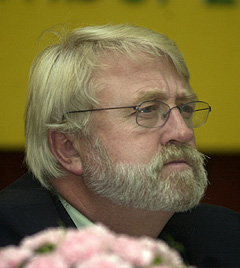 |
||||||||||||||||||||||||||||||||||||||||||||||||||||||||||||||||||||||||||||||||||||||||||||||||||||||||||||||||||||
|
Svein Tveitdal explains the work being done through UNEP-GRID to make climate change information more accessible and understandable to Parties and the general public |
||||||||||||||||||||||||||||||||||||||||||||||||||||||||||||||||||||||||||||||||||||||||||||||||||||||||||||||||||||
|
James Grabert, UNFCCC, described some of the UNFCCC’s initiatives for increasing accessibility of information on emissions inventories using examples of charts outlining emissions trends in the UK, Norway and Latvia. He explained that by displaying emissions patterns, there will be increased public understanding of climate change issues. |
||||||||||||||||||||||||||||||||||||||||||||||||||||||||||||||||||||||||||||||||||||||||||||||||||||||||||||||||||||
|
||||||||||||||||||||||||||||||||||||||||||||||||||||||||||||||||||||||||||||||||||||||||||||||||||||||||||||||||||||
 |
The climate change problem in Mongolia and Central Asian countries: Adaptation measures and Clean Development Mechanism proposals Hijaba Ykhanbai, Mongolia, described the impacts of climate change in Mongolia and possible adaptation measures. He explained that adaptation measures for rangeland and livestock include awareness-raising and assessment measures. Regarding water shortages, he highlighted adaptation proposals, including: strengthening institutional capacity; prioritizing funding; increasing public awareness; using renewable energy sources; restoring forests and degraded pasture lands; and studying the possibility of diverting rain and snow run-off toward desert areas. Alexey Kokorin, WWF Russia, introduced a WWF brochure on climate change in Arctic regions and CDM projects proposals for Russia and Mongolia. Kayumov Abdulhamid, Tajikistan, outlined adaptation measures for ice cover and water resources loss in Tajikistan, including monitoring and constructing new hydropower sources. Noting that 60-70% of Tajikistan’s territory is agricultural land, and highlighting climate change impacts on human health, he said adaptation requires management measures and scientific, social and economic mechanisms and programmes. Tatyana Ososkova, Uzbekistan, stressed interlinkages between, inter alia, climate change, human activity, land degradation, water resources reduction, and biodiversity decline. Highlighting a water resources shortage in the Aral Basin, temperature changes, and extreme drought in 2000, she said possible adaptation measures include optimizing water and land resources use, an integrated approach and enabling activities. Bazarsad Chimed-Ochir, WWF Russia, introduced proposals to address overgrazing in Mongolia. He recommended establishing grazing management plans that would involve all stakeholders. |
|||||||||||||||||||||||||||||||||||||||||||||||||||||||||||||||||||||||||||||||||||||||||||||||||||||||||||||||||||
|
Tatyana Ososkova, Uzbekistan, recommended integrated adaptation measures to address shortages of water resources and temperature changes |
||||||||||||||||||||||||||||||||||||||||||||||||||||||||||||||||||||||||||||||||||||||||||||||||||||||||||||||||||||
 |
||||||||||||||||||||||||||||||||||||||||||||||||||||||||||||||||||||||||||||||||||||||||||||||||||||||||||||||||||||
|
Alexey Kokorin, WWF Russia |
||||||||||||||||||||||||||||||||||||||||||||||||||||||||||||||||||||||||||||||||||||||||||||||||||||||||||||||||||||
|
||||||||||||||||||||||||||||||||||||||||||||||||||||||||||||||||||||||||||||||||||||||||||||||||||||||||||||||||||||
|
Sinks in the CDM Lee Hayes Byron, CAN, called for definitions and modalities to minimize the potential risks of sinks in the CDM. Jutta Kill, SinksWatch, stressed the high social and environmental risks of including monoculture tree plantations in the CDM, and recommended that such plantations be excluded. Bill Barclay, Greenpeace, highlighted the importance of keeping the definitions for afforestation and reforestation agreed in the Marrakech Accords. Noting Canadian and Colombian proposals to change the base year, he argued that these proposals risk increasing deforestation, and reduce the "buffer" period between deforestation and reforestation. Stephen Kelleher, WWF, highlighted the need for additional criteria for afforestation and reforestation, and for Parties to look at the social and environmental impacts of CDM sink activities. He called for specific procedures for social and environmental impact assessments that are supported by safeguard policies. |
||||||||||||||||||||||||||||||||||||||||||||||||||||||||||||||||||||||||||||||||||||||||||||||||||||||||||||||||||||
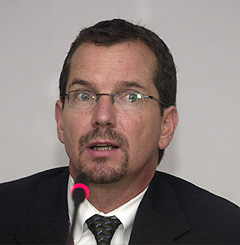 |
||||||||||||||||||||||||||||||||||||||||||||||||||||||||||||||||||||||||||||||||||||||||||||||||||||||||||||||||||||
|
Stephen Kelleher, WWF |
||||||||||||||||||||||||||||||||||||||||||||||||||||||||||||||||||||||||||||||||||||||||||||||||||||||||||||||||||||
|
John Lanchbery, Birdlife International, summarized the requirements for both project-specific baselines and baselines linked to national performance on forestry. He stressed the need for reliable baselines to ensure accurate accounting for removals by sinks. Jeff Fiedler, Natural Resources Defense Council, called for specific guidance on leakage to promote consistency and environmental effectiveness. He recommended that SBSTA develop appropriate methodologies for specific project types and all types of leakage. He noted the need for direct monitoring and standard default factors, and stressed that commercial plantations have a high potential for leakage and should be ineligible in the CDM. Malte Meinshausen, Greenpeace, highlighted the Protocol's requirement that all CDM projects result in "real, measurable and long-term benefits". He stressed that: sinks are not permanent; sinks with full liability are not equivalent to permanent emission reductions; and the carbon storage of eligible projects should be sustainable for hundreds of years. |
||||||||||||||||||||||||||||||||||||||||||||||||||||||||||||||||||||||||||||||||||||||||||||||||||||||||||||||||||||
|
||||||||||||||||||||||||||||||||||||||||||||||||||||||||||||||||||||||||||||||||||||||||||||||||||||||||||||||||||||
 |
Vulnerability & adaptation, northern perspectives and CDM opportunities in the Chilean transportation sector This side event was convened in three sessions. On reducing climate change vulnerability through sustainable livelihoods, John Drexhage, IISD, and Brett Orlando, IUCN, introduced a partnership between disaster risk management, climate change, natural resources management, and poverty eradication constituencies to encourage community-based resources management. Madeleen Helmer, International Red Cross, stressed the benefits of a Red Cross disaster preparedness programme involving mangrove planting in Vietnam. Bill Dougherty, SEI, introduced a community rangeland rehabilitation project in Sudan aiming at enabling community-initiated livelihood alternatives. Nadir Awad, Sudan, stressed the benefits of the project including increased resilience to drought through adoption of community contingency plans and eco-friendly grazing plans. Regarding northern Canadian perspectives on climate change, Grand Chief Ed Schultz, Council of Yukon First Nations, highlighted the need to involve indigenous people in climate change decision making. He noted the Arctic Council’s endorsement of a climate impact assessment process to develop policy recommendations and integrate traditional knowledge in the process. Pamela Kertland, Natural Resources Canada, outlined climate change impacts in Canada’s North. John Drexhage, IISD, presented three of IISD’s community based mitigation projects to sustain livelihoods in northern Canada. He highlighted, inter alia, the need to integrate traditional knowledge and Western-based science to advance knowledge for mitigation and adaptation. |
|||||||||||||||||||||||||||||||||||||||||||||||||||||||||||||||||||||||||||||||||||||||||||||||||||||||||||||||||||
|
Grand Chief Ed Schultz, Council of Yukon First Nations, stresses that indigenous people from Annex I Parties also require assistance implementing adaptation and mitigation measures |
||||||||||||||||||||||||||||||||||||||||||||||||||||||||||||||||||||||||||||||||||||||||||||||||||||||||||||||||||||
|
Regarding capacity building in the Chilean transportation sector, Juan Searle, Chile, stressed Chile’s commitment to the Kyoto Protocol and the CDM. Eduardo Sanhueza, CC&D, highlighted the goals of Chile’s national strategy for the transportation sector, including capacity building, quantitative estimation of existing emission reductions potentials, and developing adequate institutional arrangements. He said necessary measures needed include the rationalization of public transportation networks, disincentives to using automobiles, and the enhancement of vehicle efficiency. Ned Helme, CCAP, outlined the CCAP’s recent work in Chile, including the analysis of the Chilean transportation sector, preparation of case studies, and expansion of the institutional capacity of relevant government authorities. |
||||||||||||||||||||||||||||||||||||||||||||||||||||||||||||||||||||||||||||||||||||||||||||||||||||||||||||||||||||
|
||||||||||||||||||||||||||||||||||||||||||||||||||||||||||||||||||||||||||||||||||||||||||||||||||||||||||||||||||||
|
Making forest carbon markets work for poor forest and farm producers Mark Poffenberger, Community Forestry International (CFI), on behalf of Sara Scherr, Forest Trends, explained that forest carbon projects can have positive livelihood benefits for local communities. He said low-income producers can meet the carbon criteria, but that supportive CDM rules and host country policies are necessary to overcome barriers such as transaction costs. Emmanuel D’Silva, CFI, outlined village-based forest restoration opportunities and constraints under the CDM, focusing on research carried out in Andhra Pradesh. He noted social, institutional, and ecological constraints to successful CDM projects in India, and highlighted that problems such as transaction costs will need to be addressed. George Fowkes, Future Forests, explained how community-based projects can attract investors, stressing advantages offered by such projects, including flexible multiple income streams, low-cost labor, and readily available scrap timber. Discussion: Participants addressed, inter alia: the opportunity costs of the CDM; cultural impacts of CDM projects; the possibility that the investment benefit of low-labor costs may counter the CDM’s objective of promoting sustainable development; and the ineligibility of proposed forestry projects based on current LULUCF definitions. |
||||||||||||||||||||||||||||||||||||||||||||||||||||||||||||||||||||||||||||||||||||||||||||||||||||||||||||||||||||
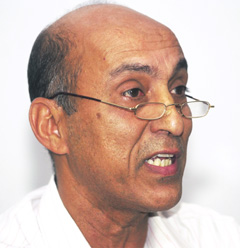 |
||||||||||||||||||||||||||||||||||||||||||||||||||||||||||||||||||||||||||||||||||||||||||||||||||||||||||||||||||||
|
Emmanuel D’Silva, Community Forestry International (CFI), discusses the results of CFI’s study on the impacts and feasibility of community-based CDM forestry projects in Andhra Pradesh, India |
||||||||||||||||||||||||||||||||||||||||||||||||||||||||||||||||||||||||||||||||||||||||||||||||||||||||||||||||||||
|
|
||||||||||||||||||||||||||||||||||||||||||||||||||||||||||||||||||||||||||||||||||||||||||||||||||||||||||||||||||||
|
|
||||||||||||||||||||||||||||||||||||||||||||||||||||||||||||||||||||||||||||||||||||||||||||||||||||||||||||||||||||
|
||||||||||||||||||||||||||||||||||||||||||||||||||||||||||||||||||||||||||||||||||||||||||||||||||||||||||||||||||||
|
Special UNFCCC side event on research |
||||||||||||||||||||||||||||||||||||||||||||||||||||||||||||||||||||||||||||||||||||||||||||||||||||||||||||||||||||
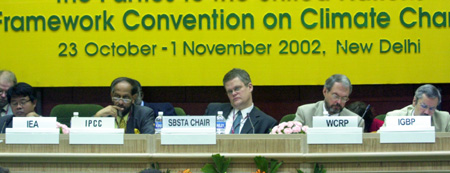 |
||||||||||||||||||||||||||||||||||||||||||||||||||||||||||||||||||||||||||||||||||||||||||||||||||||||||||||||||||||
|
The UNFCCC Secretariat presented a special UNFCCC side event on Monday morning providing Parties an opportunity to exchange views with the IPCC and others on research recommendations identified in the IPCC’s Third Assessment Report and other related issues. The event was chaired by Halldor Thorgeirsson, Iceland, and included the following panelists: P.K. Pauchauri, Chair, IPCC; S. Solomon, Co-Chair IPCC Working Group I; M. Parry, Co-chair IPCC Working Group II; O. Davidson, Co-Chair IPCC Working Group III; David Carson, World Climate Research Programme; A. Sari, International Human Dimensions Programme on Global Environment Change; W. Steffen, International Geosphere-Biosphere Programme; J. Pershing, International Energy Agency; and H. Zeigler, International Group of Funding Agencies for Global Change Research. |
||||||||||||||||||||||||||||||||||||||||||||||||||||||||||||||||||||||||||||||||||||||||||||||||||||||||||||||||||||
|
||||||||||||||||||||||||||||||||||||||||||||||||||||||||||||||||||||||||||||||||||||||||||||||||||||||||||||||||||||
|
||||||||||||||||||||||||||||||||||||||||||||||||||||||||||||||||||||||||||||||||||||||||||||||||||||||||||||||||||||


